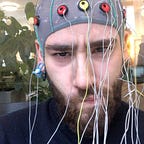Emerging game-changers in Health Technology
In this post, we will be covering emerging technologies in the current Health Techs-scene that will change healthcare as we know it radically.
The technologies mentioned in this article can be generally categorized into three different groups (i) Diagnostics, (ii) Treatment, and (iii) Cybernetics (Human Augmentation).
I will be putting them into two sections. The ‘soon to come’ technologies and those that are on the horizon.
Within these groups, there are some reemerging trends:
- Health Technology integration in consumer electronics.
- Developments in genetic engineering
- Human-machine interfaces
Let’s dive in and take a look at the game-changers!
The ‘soon to come’
Smartphones and accompanying smartwatches are increasingly becoming multifunctional health data monitoring devices, a swiss army knife of health monitoring. Together with AI-enabled data analysis, we will witness new software that will be capable of self-diagnosis and alerts to visit your doctor. This is in no way a replacement of your healthcare professional, but it’s definitely a game-changer for the primary care sector as we know it, since we will be witnessing a shift from going to your doctor when you’re sick to treat your illness, to a world where you more often will go to the doctor for prophylactic treatment, in order to avoid getting sick in the first place.
There’s a lot of quackery out on the internet regarding biohacking, which is a real shame since the original essence of the term will be the new way of approaching personal healthcare. Specifically, biohacking will be a crucial part of the integration of personalized medicine into our current healthcare systems. Together with the exponential increase in personal health data monitoring with the help of smartphones and other consumer electronics, as mentioned above, we will be seeing the development of platforms that analyze your data the given advice on the management of one’s own biology through personalized routines, workouts and nutritional advice.
Be aware! As mentioned before, there’s a lot of supplement companies trying to steal the term in their marketing. After all “bio-hacking” sounds really cool and science-like. Among medical professionals, it’s widely accepted that they are mostly selling BS.
Lab-on-chip is another branch of health technology that we will be hearing more about in the mainstream. Currently, research in Lab-on-a-chip is exploding, which can also be seen in the number of universities offering courses in the otherwise relatively new field.
In short, a Lab-on-chip system is a device that integrates one or several laboratory functions on a single integrated circuit. This enables continuous monitoring of blood concentrations of hormones, ions, and drugs. Once again, this will move healthcare towards catching diseases in their development, both for prevention, but also in order to help doctors adjust drugs patients, helping them counter disease progression and side effects of drugs.
Smart textiles are the wearable fabric that can collect much higher quality of health data monitoring than it’s smart- counterparts (and can even be part of other smart devices e.g. smartwatches), such as in-depth sleep analysis, pulse-analysis, intrinsic energy-harvesting, and storage from your own body and devices that help disabled people e.g. sign-to-speech gloves, which translate sign language into speech from your smartphone.
On the horizon
With the radical leaps we are witnessing in genetic engineering and specifically organoid development, we are closer to “organ-printing”, although we are still far from reaching a level that is ready for regulatory approval. When ready, we will be able to grow new organs that can replace failing otherwise new organs. Although, in the beginning, we will most likely witness growing subsections and modules of the whole organ, and replace smaller parts.
This brings us to enhanced organs, engineered replacement parts for our organs, which perform superiorly compared to the original functions of the organ or organ parts. These can be artificial red blood cells that can carry customizable levels of blood gasses or livers and kidneys with customizable function levels and protein expression.
Now that we’ve taken a dip into genetic engineering, let’s plunge in! Gene therapy is a hot potato and there are currently less than a handful of approved treatments by the FDA and EMA combined (and the treatments are some of the most expensive drugs out there). There’s no doubt that gene therapy still is in its infancy, but as it develops and lawmakers get more adjusted we will be seeing prenatal gene manipulation (there’s already one unfortunate case in China) as well as epigenetic therapies.
Finally, we have the case of cybernetics and human augmentation (my own field of study), where we will be witnessing devices that enable biologically extended senses, bionic implants, and brain-computer interfaces (both invasive and non-invasive).
Would you like a deep dive into any one of these technologies? I would love to write about the science and technical aspects of the above mentioned as well!
Let me know by posting a comment :)
